
PUNG-CHOW
THE GAME OF A HUNDRED
INTELLIGENCES
Also known as
MAH-DIAO
MAH-JONG
MAH-CHEUK
MAH-JUCK
and
PE-LING
By L. L. HARR

HARPER & BROTHERS, Publishers
New York and London
This eBook is for the use of anyone anywhere at no cost and with almost no restrictions whatsoever. You may copy it, give it away or re-use it under the terms of the Project Gutenberg License included with this eBook or online at www.gutenberg.org
Title: Pung Chow
The Game of a Hundred Intelligences. Also known as Mah-Diao, Mah-Jong, Mah-Cheuk, Mah-Juck and Pe-Ling
Author: Lew Lysle Harr
Release Date: November 23, 2008 [eBook #27318]
Language: English
Character set encoding: ISO-8859-1
***START OF THE PROJECT GUTENBERG EBOOK PUNG CHOW***
NOTE
PUNG-CHOW
INTRODUCTION
SUMMARY OF THE GAME
DESCRIPTION OF TILES
PROCEDURE OF PLAY
FOUR OF A KIND
MAH-JONGG OR MAH-DIAO
SETTLING THE SCORES
SUGGESTIONS FOR CAREFUL PLAYING OF HANDS
USE OF THE MANDARINS
SCORE CARD
EXAMPLE OF HANDS AND HOW THEY ARE SCORED
ILLUSTRATIONS OF SCORE SETTLING
PART TWO
PLAYING WITH A LIMIT
THE PROCEDURE OF PLAY
BONUS SCORES
LIMIT HANDS
SCORING VALUES
EXPLANATION OF ITEMS IN THE TABLE OF SCORING VALUES
DOUBLING HONOR SCORES
PENALTIES
EXAMPLE OF WINNING HANDS
TWO AND THREE-HANDED GAMES
Table of Contents
ERRATA
Transcriber's Notes
Transcriber's notes and corrections are highlighted like this, and Errata noted in the original book are highlighted like this. Mouse over the underlined text to view notes.

Also known as
MAH-DIAO
MAH-JONG
MAH-CHEUK
MAH-JUCK
and
PE-LING
By L. L. HARR

HARPER & BROTHERS, Publishers
New York and London
Copyright, 1922
By L. L. HARR
Printed in the U. S. A.
Mr. L. L. Harr's skill in the game of Pung Chow has been acquired through more than twenty years of intimate contact with the business and official circles of cultured Chinese in Canton, Shanghai, Tientsin, Pekin and other centers of China. Mr. Harr has enjoyed more opportunity to mingle in polite Chinese society than any other European or American resident I knew in China.
Mr. Harr, in consequence, was perhaps one of the first foreigners who learned the game from the best players in China. What is more, Mr. Harr's unusually keen appreciation and enthusiasm were largely instrumental in arousing the popularity of this extraordinarily fascinating Chinese game in the Western Hemisphere. To use a familiar American phrase, Mr. Harr was unquestionably one of the pioneers who put "PUNG CHOW" on the map west of Suez.
Mr. Harr has not only brought the game to America, but has written the first authoritative book on "Pung Chow," based on the best modern methods of Chinese play.
J. D. BUSH,
Professor of English Literature,
Pekin National University,
Pekin, China.
January, 1923.

PUNG-CHOW
For Hands Played Without a Limit
Winning Hand Bonus Scores
| For Mah-Jong | 20 points |
| For no sequences in hand or on table | 210 points |
| For no other score than Mah-Jong in hand or on table | 10 points |
| For winning on a draw from the loose tiles | 10 points |
| For drawing the winning piece | 2 points |
| For filling in the only place to win | 2 points |
Combination Scores
| On Table (Exposed) | In Hand (Concealed) | |
| For 3 of a kind of twos, threes, fours, fives, sixes, sevens or eights | 2 points | 4 points |
| For 3 of a kind of ones, nines, winds or dragons | 4 points | 8 points |
| For 4 of a kind of twos, threes, fours, fives, sixes, sevens or eights | 8 points | 16 points |
| For 4 of a kind of ones, nines, winds or dragons | 16 points | 32 points |
| For a pair of any dragon or the player's own wind | 2 points |
Doubling Honors
| For three (or four) green dragons, | double total score once. |
| For three (or four) red dragons, | double total score once. |
| For three (or four) white dragons, | double total score once. |
| For three (or four) of own wind, | double total score once. |
| For having all one suit except honor pieces, | double total score once. |
| For all one suit, | double total score 3 times. |
| For all honor pieces, | double total score 3 times. |
| For winning on original hand as drawn from the wall, | double total score 3 times. |
See page 65 for scoring values when hands are played with a limit.
Out of China has come this stately game with the lure of Oriental mysticism to whet jaded appetites and with possibilities for study that challenge the keenest intelligence.
There is a mysticism about the Oriental and his mode of life that challenges the imagination and induces a curiosity hard to decipher. The dress of the Chinese, their strange customs, their difficult language, and their apparently impenetrable mask-like faces appeal to the fancy and throw a veil of mystery around even the commonplace.
The origin of this game is lost in the mist of centuries past. There is, though, an oral tradition to the effect that it was originated in the Court of the King of Wu, now known as Ning-Po, during the year of 472 B.C. to entertain his consort and her court ladies and to help them while away the time which lay heavily on their hands. This was about the time of Confucius. It is, however, known to have been the Royal game, restricted to the use of Emperors and their friends of the Mandarin class for two thousand years. To them it was known as Pe-Ling (pronounced Bah-Ling) taking its name from the "bird of a hundred intelligences," the lark-like creature sacred in the Chinese faith which now may be seen reproduced on most Chinese tapestries and embroideries. The penalty paid by one of any other class for playing Pe-Ling at that time, was the loss of his head. Later—no one knows just when—the privilege of playing this wonder game was extended to the merchant or middle classes—and when, some 70 years ago—a social uprising threatened, one of the concessions granted to calm the unrest was the universal privilege of playing this game. In this way was caused the confusion of names for the game which exists even to-day in China; for, with the abolishing of Pe-Ling, each province applied their own name and pronunciation to the game, with the result that now we have from twelve to eighteen different names, by which the game is known. A few of these are Ma-Cheuk, Mah-Jong, Mah-Juck, Mah-Diao and Mah-Jongg.
Pung Chow is made to withstand the climatic conditions which soon destroy the article imported under the name of Mah-Jongg and the other corruptions of Mah-Diao, and it is the true and original Chinese game translated by the addition of numerals just enough to be readily understood and not enough to spoil the artistry of the tiles. The addition of numerals has been overdone in the marking of many of the cheaper imported sets, and give the appearance of having had numerals sprinkled on them regardless of where they may land and permitted to stay.
The fundamentals of this game are simple and require only practice to master. The science of Pung Chow must in the greater part be studied out by the individual player and one may spend the rest of his life in attaining to past mastery in its thousand-fold intricacies.
Before going thoroughly into the details of the playing of the game, it is better to give a general view of the play and its object.
Pung Chow is played by thoroughly shuffling all of the tiles face down in the middle of the table, and forming them in a double-tiered, hollow square, called the wall. This wall is then broken at some point determined by the dice and each player draws an original hand of 13 tiles. This leaves about two-thirds of the wall intact, and the rest of the play is devoted to drawing and discarding from this remainder of the wall; each player improving and matching his own individual hand until having arranged it into four sets and a pair, some player wins. A set is three of a kind, four of a kind or three in a sequence. Every set has a scoring value, and the players add their scores and settle after every hand. A player may win with a score as low as 22 points or scores may run to 380,928 points. These possibilities will unfold as the following pages on the details of the play are read.
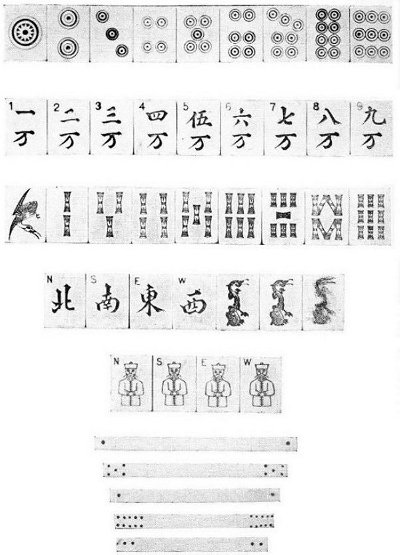
The game is played with 136 tiles, which are divided into four distinct and separate suits. These four suits are called the Bamboo, Dot, Character and Honor Suits.
The first three of these suits score equally and are arranged in the same manner, that is, there are 36 tiles in each, numbering from one to nine, and there are four tiles of each numeral.
The fourth suit, known as the honor suit, is divided into three parts: the Dragons, the Winds and the Mandarins. Of the Dragons, there are four apiece of three different kinds, the Red, Green and White Dragons. The Winds are North, South, East and West with four tiles alike for each. The Mandarins (also called Seasons, and Flowers), are 8 in number, and as they are only used in limit hands, will be discussed later.
From Illustration No. 2 a player will see that there are four of every different tile in the set, and that there are 34 different tiles.
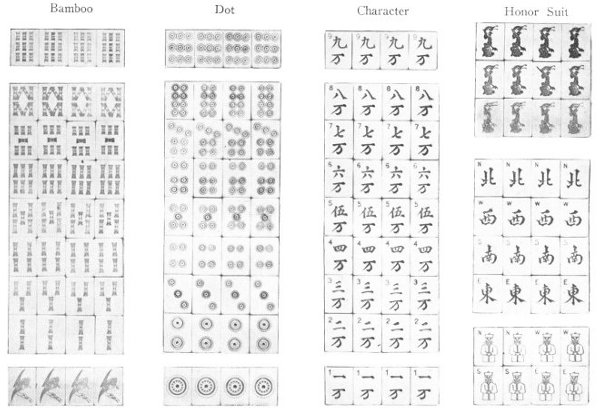
Position of the players for the first game is determined by a throw of the dice; all players throw once, the one throwing the highest number becoming first East Wind. In the event of a tie, players tieing throw again. The player sitting opposite East Wind will be known as West Wind, to the right of East Wind as South Wind, and the left of East Wind, as North Wind. The dice need only be thrown to determine East Wind for the first game of an evening's play, for if the player representing East Wind wins, or if the game is a draw, he remains East Wind. If he loses, the player to his right becomes East Wind, he in turn becoming North Wind.
East Wind is sometimes called Banker, for he must pay double stakes when he loses, and wins double stakes when he wins.
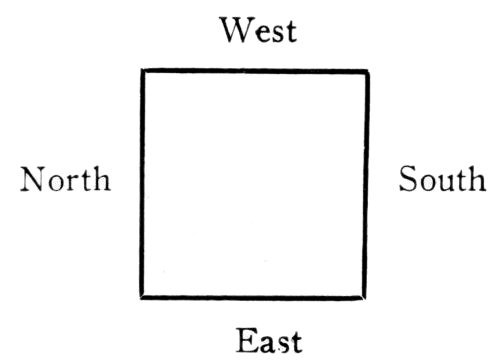
Before building the wall the tiles must all be turned face down on the table and thoroughly shuffled. Then each player proceeds to build one side of the wall by taking 34 of the tiles at random, and arranging them side by side in a row 17 tiles long and 2 tiers high.

Each player then moves his side of the wall forward, the four sides forming a hollow square. This represents a Chinese wall or fort common in the protection of cities.
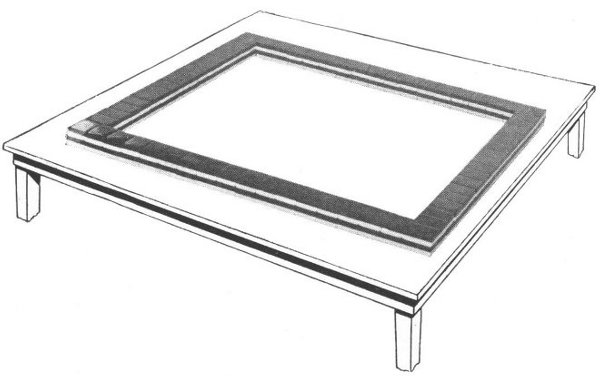
To find the point at which the wall is to be broken, East Wind always throws the dice. The number thrown will indicate the player who is to break the wall. The player is found by East Wind counting around the table to the right, starting with himself as "one," until he reaches the number thrown which will designate the player to break the wall.
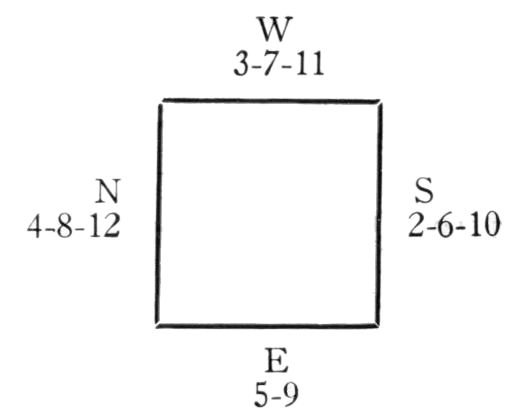
In this illustration, if East Wind threw a "7," starting with himself as one, South would be 2, West 3, North 4, East 5, South 6, and West 7, designating West as the player to break the wall.
The player who has been designated to break the wall then throws the dice to determine the exact tile at which he shall break the wall, adding this throw to East Wind. This sum will indicate the tile at which the wall is to be broken, the player to break the wall counting the sum off from the right end of his own side, i.e., if 14 is the sum of the two throws, the wall will be broken by lifting out the 14th tile from the right with the one under it and placing both on the top of the wall to the right of where it was broken. These two are called loose tiles and they mark the end of the wall.
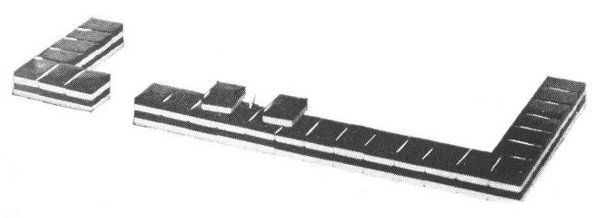
Each player then draws the 13 tiles which go to make up his original hand. East Wind starts the drawing by taking the first four tiles (2 blocks of 2 each) at the beginning of the wall, the player on his right the next four and so on around the table three times which will give each player 12 tiles. Then one tile apiece is drawn in regular order giving every player 13 tiles, except East Wind who draws an extra tile as he must make the first discard.
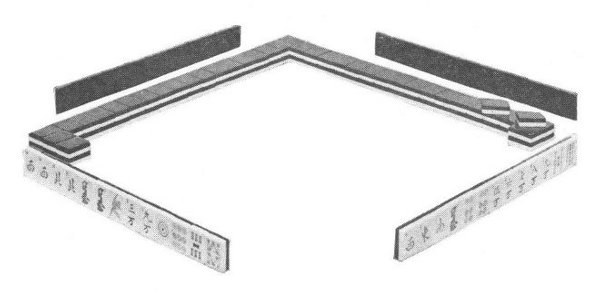
Wall showing draw.
Each player then takes his original hand and arranges it to suit his own convenience. It is advised, however, that he arrange it in suits in order to see at a glance, the value of any one tile to his hand in the drawing and discarding of which the rest of the game consists.
When the hands have been arranged, East Wind starts the play by discarding any tile in his hand, face up in the center of the table. It is because of this first discard that he drew an extra tile. The play then goes to the right, it becoming the turn of South Wind to draw the next tile in the wall and discard any one he may choose. West Wind then draws and discards and so on around the table, constantly in a counter-clockwise direction.
The players during this drawing and discarding are gradually improving their hands, and matching them into four sets and an extra tile, a set being three of a kind, four of a kind, or three in a sequence.
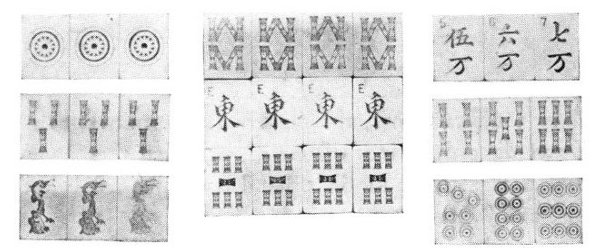
When a player accomplishes this, he must only match the extra tile forming a pair and thus, completing his hand, having four complete sets and a pair. He announces "Mah-Jongg" wins, the game is over, the scores are settled and the wall built up for the next game.
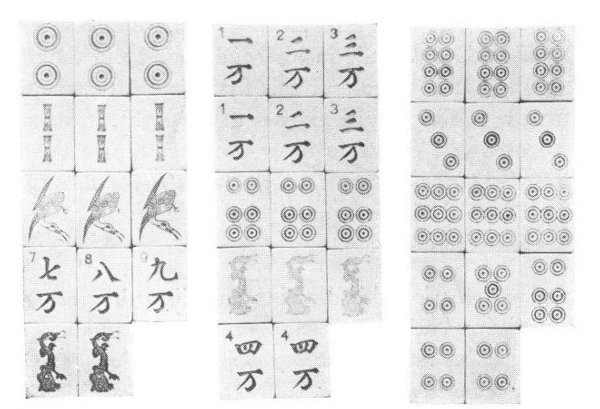
As completing a hand entirely by draw from the wall would be a difficult task, the players are permitted to make use of any discard, as it is discarded, provided they have the required tiles already in their hand as explained below in "Chow" and "Pung."
A player having two tiles in his hand which, together with the tile just discarded by the player before him (to his left), would form a sequence or run of three, may by announcing "Chow" pick up the discard, add it to the two in his hand, and place the three in sequence face up on the table to the right of his hand. This appropriating the discard serves as the player's draw and he must then discard and the play goes on in the usual manner.
For example: If one has a 5-6 of character and the player preceding him discards either a 4 or a 7 of character, he may "Chow" the tile, and discard; or ignore it and draw from the wall and discard, in hopes of building a better hand, as often will be found advisable.
The main point to be remembered in "Chowing" is that a player may "Chow" only in his regular turn, i.e., he may "Chow" only tiles discarded by the player to his left and then only when he has the other two tiles in his hand to form the sequence. Sequences can only be built up in sets of three.

A player may also appropriate another player's discard to fill a set of three of a kind or four of a kind by announcing "Pung." In order to do this, the player must have a pair, or three of a kind in his hand to match with the discard, thus completing three or four of a kind, which he places, as in the case of a "Chow," to the right of his hand, face up on the table. For example: A player having a pair or three fives of the character suit, may pung when another player discards a five character, expose his set and discard, the play going on in the regular direction from him.
It is not necessary for it to be the player's turn to draw in order to "Pung" as it is in the case of a "Chow." A player having a pair similar to a tile discarded, may announce "Pung" and appropriate the tile, regardless of who discarded it and of whose turn it is to draw. Also after a player "Pungs" and discards, the play goes on from him to the right. It can be seen that due to punging one or even two players are liable to lose their turn.

There are a few rules applying to the "Chow" and "Pung." They are as follows:
1. All tiles must be "punged" or "chowed" as they are discarded; for a tile discarded by a player and allowed to remain in discard until the next player discards, becomes "dead" and cannot be touched during the rest of the game.
2. It has been stated that one cannot "pung" unless it makes up three or four of a kind. This is true with one exception. In the case: when a tile will complete a player's hand allowing him to "Mah-Jongg," the tile may be punged. Example: A player with four sets and an odd tile may pung a tile which matches his odd one. The rule is that "a player may at any time 'Pung' a discard which will complete his hand and allow him to Mah-Jongg."
3. The denomination and suit of each tile must be announced as it is discarded, a player discarding a 3 of character, announcing 3 character, to prevent confusion of a player who may be studying his hand. This is more of a courtesy of the game, than a rule.
4. A "Pung" has precedence over a "Chow" and if one player can pung the same discard that another player can chow, the former has the right to appropriate the tile.
5. If a player can pung a discard which will complete his hand and another player can pung the same discard to complete a set, the former has the right to take the discard.
6. If two players pung the same tile to complete their hands, the precedence is given to the player claiming the tile nearest to the discarder in a counter-clockwise direction around the table.
Before speaking of "four of a kind," it is better to give the reason for exposing a set made up of a pair and a punged discard, and make clear at the same time, what is to be done when three of a kind are completed by draw.
A set made up of a pair and a punged discard must be "exposed" by setting it out face up, on the table to the right of the players' tiles, first, to show to the other players that he had the required pair, which gave him the right to appropriate the discard, and secondly, to separate the set from those completed entirely by draw from the wall. Sets completed by help of an appropriated (punged) discard, have only one-half the scoring value of exactly the same sets, completed by draw from the wall and kept in the hand.
Thus there are many advantages in drawing the third tile to complete a set of three of a kind when compared to "punging" the same, for in the former case, the set has twice as much scoring value, they are kept concealed in the hand and the opponents can only guess as to how nearly complete a concealed hand may be. A concealed set is counted as one of the four sets required to win, just as an exposed set would be, and a player having a set of three of a kind concealed has very good chances of filling it and thus forming four of a kind which counts a great deal higher.
A player may complete a set of four of a kind either by draw from the wall or "punging" an opponent's discard, if he has three of a kind already in his hand. In either case he must place the completed set on the table to the right of his tiles; all four face up if he "punged" the fourth, the two end tiles face down if he has "drawn" the fourth.
The player must immediately draw a "loose tile" (one of the two tiles on top of, and marking the end of the wall). Usually the one farthest from the end is taken, the one on the end moved up, and replaced by a tile from the end of the wall itself.
The "loose tile" was drawn because every time a player completes a set of four of a kind, he causes the rest of his hand to be one tile short. This must be made up every time four of a kind is filled by an extra tile drawn from the "loose" tiles.
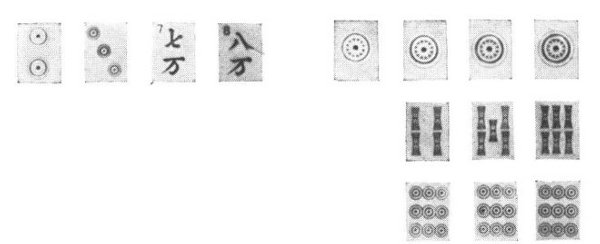
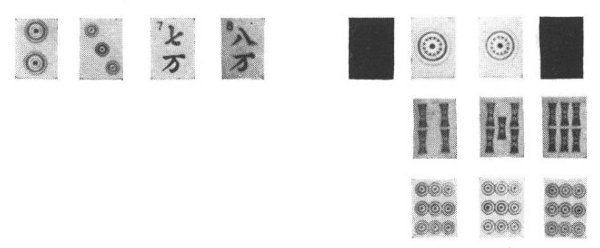

In any set which a player may have exposed on the table there must not be more than (1) punged tile.
A player having three of a kind in his hand may pung the fourth when it is discarded or having three of a kind on the table and drawing the fourth may add it to his 3 exposed tiles. The rule, however, bars him from appropriating some one else's discard to make a fourth for an exposed set of three of a kind because in order to appropriate this discard he would have to pung it. This he has not the privilege of doing, because he already must have one "punged" tile in his exposed set or it wouldn't be exposed.
As has been mentioned before when a player has matched his hand into four (4) sets and by a draw or a pung has mated the final pair he wins and announces "Mah-Jongg" or "Mah-Diao" (Dee-O), either being correct and in common usage, the latter being the most logical because of its English translation "mating the pair." A player must at all times during the game have thirteen (13) tiles, his draw every round momentarily giving him fourteen (14), his discard leaving him the thirteen (13). Then for every four of a kind that he fills he should have an extra tile in his hand on account of the extra loose tile draw.
Thus one is able at any time during the game to check his hand and ascertain whether or not he has the correct number of tiles in it. If he has not sets of four of a kind he should have thirteen tiles in his hand. If he has one set of four of a kind he should have fourteen tiles in his hand, two sets of four of kind 15 tiles, and so on.
If, at any time during the game, a player has an incorrect number of tiles in his hand, it becomes "dead." He must continue drawing and discarding, but when the scores are settled his score does not count and therefore he must pay all players. His only chance lies in endeavoring to prevent the other players from completing their hands, by holding the tiles which he believes they need and thus causing a draw game.
When the first player to complete his hand calls "Mah-Jongg" the game is ended, and all players expose their hands and count up their scores. The winner of the game collects full value of his score from each of the other players and throwing his hand into the discard is thru for that game.
The remaining three players then settle among themselves the difference of their scores, the high hand of the three collecting the difference between his score and each of the remaining two players. Then throwing his hand into the discard, leaves the remaining two to settle their scores, the highest hand of which collects the difference.
It must be remembered here that East Wind (or banker) pays or collects double, if he loses or wins.
Scores are most conveniently settled by the use of the counters which are furnished with the sets. These are spotted to denote different denominations and at the end of every hand the actual scores or differences in scores are settled between players by the exchange of these counters. There are several styles of counter sets. The one in most common usage contains counters valued as follows:
| Points | |
| 1 Gold dot | 1,000 |
| 5 Black dots | 500 |
| 1 Black dot | 100 |
| 10 Red dots | 10 |
| 2 Red dots | 2 |
In a game of this nature where every hand is different from the preceding one and so much depends on the draw, it is very hard to lay down any specific rules of how it should be played. There are, however, a few points which would help if kept in mind during the play. A player should study his original hand and after the first few draws and discards form a general plan of what he is going to try and fill in his hand and decide on how high a score he will have a good chance of making. This will be decided by:
1. The condition of his own hand.
2. The discards of the other three players.
If he has an exceptionally strong hand in any one suit he will play for that suit regardless of the other players. If he has a well-divided hand, by watching the other players' discards, he will be able to form a fairly good opinion of what they are doing with their hand.
After judging his hand, visualizing the sort of hand that he is to try to fill, he should use his own judgment in drawing and discarding, constantly watching his own hand for opportunities and his opponents' discards for disclosures, and upon the slightest suspicion that one of these opponents is nearing the completion of his hand, should immediately forego any thoughts of a higher hand himself and seek to complete his own hand as quickly as possible.
Summing this up; a player should plan and play to win at all times with as high a hand as possible, then as the wall grows shorter and the probability of one of the opponents completing his hand grows larger, the player should reconsider, and
1. If he has at that stage an exceptionally good hand which will win back for him from the other two players that which he loses to the winner, should go on improving his hand and take the chance of another player winning.
2. If he has just an ordinarily good hand he should stop playing to improve his hand and start to complete it as quickly as possible, i.e., form sequences and mix suits, in order to win before the other players and save himself.
3. If his hand has not improved at all or very little since the beginning of the game and he has small chance of completing his hand in any way before some other player does, his only plan is to hold the tiles which he thinks would help the other players and discard only those which he is sure they will not pung. These tiles can be ascertained by carefully searching the discards in the center of the table and the sets already exposed by the other players. By playing this way he may be able to cause the game to be a draw.
There are a few other points which are taken up in the last four layouts in Part I.
The Mandarins, also called Flowers and Seasons, are eight in number, two for each of the four winds. They may be eliminated from the set and are not usually used in the play, as they add a large element of chance into the game.
If they are used, each side of the wall is increased by two tiles, making each side a double tiered row of 18 tiles side by side.
Then, if a player draws one of his own wind mandarins, he exposes it on the table and draws a "loose tile," the mandarin of his own wind permitting him to double his score once. If then he draws the other mandarin of his own wind he repeats the above process and may double his total score again. Where "Seasons and Flowers" are used instead of mandarins the numbers on them, 1, 2, 3 and 4, represent East, South, West and North winds respectively. The red numbers are the "Seasons" and the green numbers are the "Flowers." They are used exactly as are the mandarins, i.e., One's own "Season" will double the value of his hand, as will his own "Flower." Both of them will double the value twice.
It will be seen at a glance that the scoring values are divided into three parts. First, the bonus scores which only the winner can use; secondly, the combination scores which all four players can use; finally the doubling honors which all four players may use, so it is that in settling the scores the winner starts at the top with twenty (20) points for "Mah-Jongg" or for winning and goes down the list scoring ten points, if he has no sequence in his hand and so on thru the bonus scores, adding to these whatever scores he obtains from combinations in his hand or on the table and doubling the sum as many times as he has doubling honors.
In the bonus scores for the winning hand only there are six items:
1. "Mah-Jongg" which gives 20 points for winning the hand.
2. No sequence in hand or on table. This is a bonus of 10 points given to a player if he wins without use of sequences.
3. Drawing the winning piece. This is a bonus of 2 points given to the winning player if he draws the tile which completes his hand from the wall. Of course punging the winning tile will forfeit this bonus.
4. Filling the only place to win. This is a bonus of 2 points given to a player who fills the only possible place to win, i.e., winning by matching the pair or drawing the middle tile of a sequence.
5. Winning on a draw from a loose tile. This of course is a bonus of ten points given to the winning player if any of his loose tile draws have been fortunate enough to complete his hand.
6. No other score than "Mah-Jongg" in hand or on table. This is a bonus of ten points given to the winning player having only 20 points for "Mah-Jongg" as his score, and is a hand made up of four sequences and a pair in which there is no score, a sequence having no scoring value whatsoever. Of course even drawing the winning piece will forfeit this bonus as can easily be seen.
In the combination scores exposed sets are those on the table; face up to the right of the player, concealed sets are those which are in his hand at the time of winning. As will be seen by the score card, concealed sets having been made up by the player without the assistance of a pung or chow score twice as much as the same set would if it were on the table. This together with the fact that sets of ones, nines, winds or dragons score twice as much as sets of twos, threes, fours, fives, sixes, sevens and eights should be helpful in memorizing the score which is essential to the careful playing of each hand.
As for the doubling honors, each set or combination doubles the total score once, and if there are five doubling honors in a hand, the total score should be doubled five times—for example: a player goes Mah-Jongg or Mah-Diao having 32 points in bonus scores, 18 in combination scores, making his total score 50. Then if he has five doubling honors his final score is 1,600 points, i.e., 50-100-200-400-800-1,600.
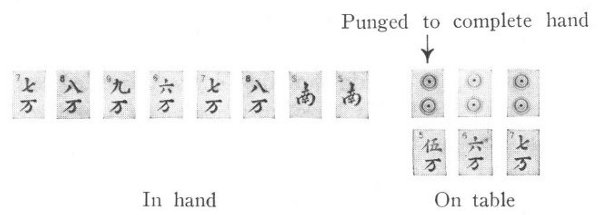
Example No. 1.
| For Mah-Jongg | 20 | |
| For Three 2 Dots | 2 | |
| 22 | Total Score | |
| No double honors: | 22 | Final Score |
In this hand the player punged the 2 dot which completed his hand, 20 for Mah-Jongg as the only bonus score he has because: 1. He has sequences. 2. He did not draw the winning piece. 3. He did not fill the only place to win. 4. He has other score than Mah-Jongg. 5. He did not win on a loose tile draw. In combination value, he has only two points for the set of three 2 dots, the sets of sequences helping complete the hand, but scoring nothing. There are no doubling honors in the hand so the final score is 22. This is the lowest winning hand that can be scored.

Example No. 2
Winner chowed the 1 character to complete hand. Score is
| Mah-Jongg | 20 | |
| No other scores on hand or on table | 10 | |
| 30 | Total Score | |
| No combination scores or doubling honors | 30 | Final Score |
| Mah-Jongg—20 | 20 | |
| No sequences—10 | 10 | |
| Filling only place to win—2 | 2 | |
| Drawing wins p.—2 | 2 | |
| 34 | ||
| 3 ones concealed | 8 | |
| 3 threes concealed | 4 | |
| 3 fives exposed | 2 | |
| 3 fours exposed | 2 | |
| 50 | Total Score | |
| No doubling honors: | 50 | Final Score |
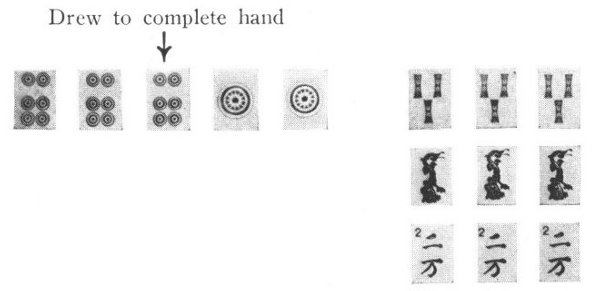
Example No. 4
| Mah-Jongg | 20 | |
| No sequence | 10 | |
| Drawing winning piece | 2 | |
| 32 | ||
| 3 sixes (concealed) | 4 | |
| 3 twos (exposed) | 2 | |
| 3 dragons (exposed) | 4 | |
| 3 threes (exposed) | 2 | |
| 44 | Total Score | |
| Double once for red dragons | 88 | Final Score |
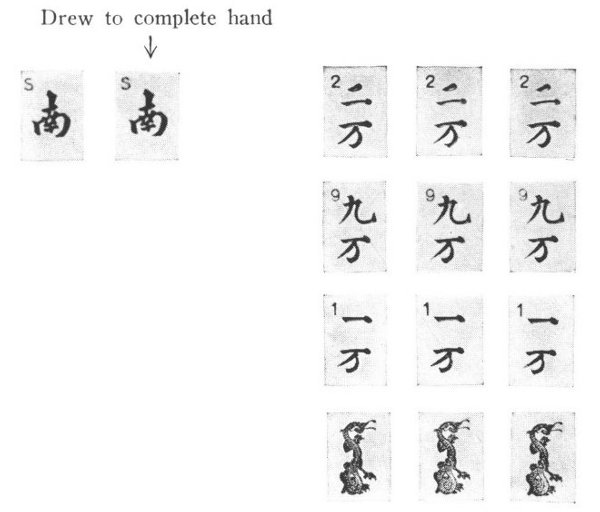
Example No. 5
| Mah-Jongg | 20 | |
| No sequence | 10 | |
| Drawing winning piece | 2 | |
| Filling only place to win | 2 | |
| 34 | ||
| 3 twos (exposed) | 2 | |
| 3 nines (exposed) | 4 | |
| 3 ones (exposed) | 4 | |
| 3 dragons (exposed) | 4 | |
| 48 | Total Score | |
| Double once for green dragons | 96 | |
| Double once for all one suit except winds or dragons | 192 | Final Score |

Example No. 6
| Mah-Jongg | 20 | |
| No sequence | 10 | |
| Drawing winning piece | 2 | |
| Filling only place to win | 2 | |
| 34 | ||
| 4 nines (concealed) | 32 | |
| 3 sevens (exposed) | 2 | |
| 3 fours (concealed) | 4 | |
| 3 ones (concealed) | 8 | |
| 80 | Total Score | |
| Double three times for all one suit | 160 | |
| 320 | ||
| 640 | Final Score |
| Mah-Jongg | 20 | |
| No sequence | 10 | |
| 30 | ||
| 4 dragons (concealed) | 32 | |
| 4 winds (exposed) | 16 | |
| 3 dragons (exposed) | 4 | |
| 3 dragons (concealed) | 8 | |
| 90 | Total Score | |
| Double three times for all one suit (honor) | 180 | |
| 360 | ||
| 720 | ||
| Double once for red dragons | 1440 | |
| Double once for white dragons | 2880 | |
| Double once for green dragons | 5760 | Final Score |
If this hand is held by the East Wind he may double again for having a set of his own wind, making his score 11,520, and being East Wind, he collects double from each player when he wins, making his total 23,040 from each of the other three players or 69,120 in all.
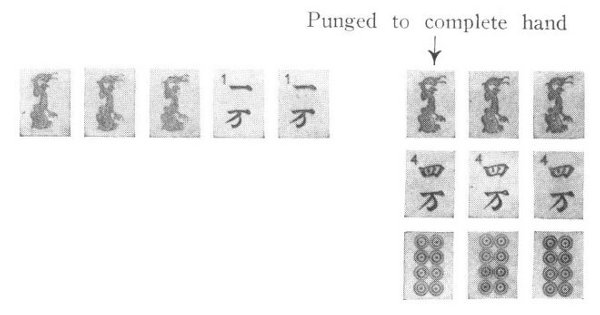
Example No. 8
| Mah-Jongg | 20 | |
| No sequence | 10 | |
| 30 | ||
| 3 dragons (exposed) | 4 | |
| 3 fours (exposed) | 2 | |
| 3 eights (exposed) | 2 | |
| 3 dragons (concealed) | 8 | |
| 46 | Total Score | |
| Double once for white dragons | 92 | |
| Double once for green dragons | 184 | Final Score |
If player is East Wind, he collects double, or 368 from each player. If any other wind, he collects 368 from East Wind and 184 from the other two players.
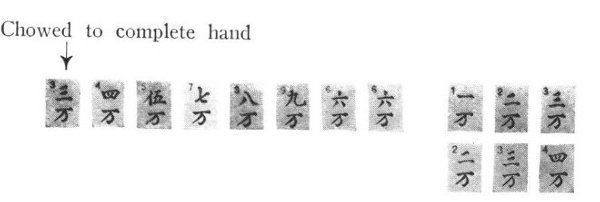
Example No. 9
| Mah-Jongg | 20 | |
| No sequence | 10 | |
| 30 | Total Score | |
| Double three times for all one suit | 60 | |
| 120 | ||
| 240 | Final Score |
Note: In this hand the player did not even fill the only place to win as a 6 character would have won also.
If player is East Wind, he collects 480 from each of the other three players. If any other wind, he collects 480 from East Wind and 240 from the other two players.
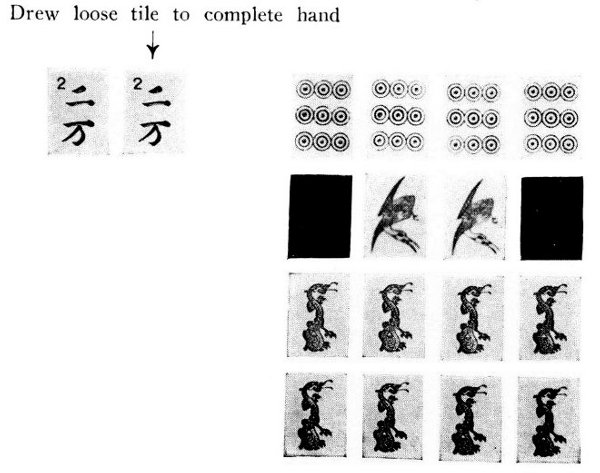
Example No. 10
| Mah-Jongg | 20 | |
| No sequence | 10 | |
| Winning on loose tile draw | 10 | |
| Drawing winning piece | 2 | |
| Filling only place to win | 2 | |
| 44 | Total Score | |
| 4 nines (exposed) | 32 | |
| 4 ones (concealed) | 16 | |
| 4 dragons (exposed) | 16 | |
| 4 dragons (exposed) | 16 | |
| 124 | Total Score | |
| Double once for red dragons | 248 | |
| Double once for green dragons | 496 | Final Score |

Example No. 11
| Mah-Jongg | 20 | |
| No sequence | 10 | |
| Drawing winning piece | 2 | |
| 32 | ||
| 3 winds (concealed) | 8 | |
| 3 dragons (concealed) | 8 | |
| 3 twos (concealed) | 4 | |
| 3 nines (concealed) | 8 | |
| 60 | Total Score | |
| Double once for all one suit except winds or dragons | 120 | |
| Double once for red dragons | 240 | |
| Double once for own wind | 480 | Final Score |
This illustration assumes player to be North Wind. This player collects double, or 960, from East Wind and 480 each from South and West Winds.
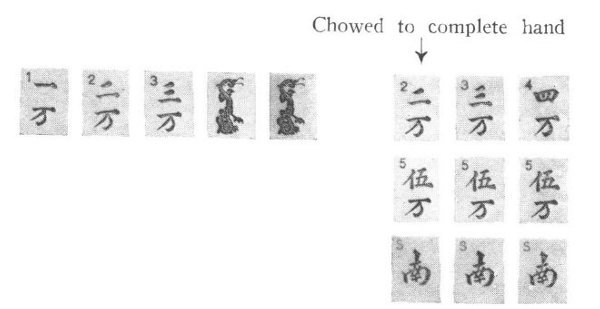
Example No. 12
| Mah-Jongg | 20 | |
| 20 | ||
| 3 fives (exposed) | 2 | |
| 3 winds (exposed) | 4 | |
| 2 dragons | 2 | |
| 28 | Total Score | |
| Double once for all one suit except winds or dragons | 56 | Final Score |
Note: Two points for pair of red dragons. Dragons and own wind are only pairs that score, and they are limited to two points.
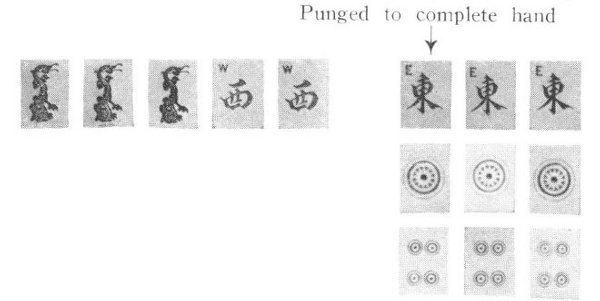
Example No. 13
PLAYER IS EAST WIND
| Mah-Jongg | 20 | |
| No sequence | 10 | |
| 30 | [Pg 41] | |
| 3 winds (exposed) | 4 | |
| 3 ones (exposed) | 4 | |
| 3 fours (exposed) | 2 | |
| 3 dragons (exposed) | 8 | |
| 48 | Total Score | |
| Double once for all one suit except winds or dragons | 96 | |
| Double once for red dragons | 192 | |
| Double once for own wind | 384 | |
| Collect double from each player being east wind and winning | 768 | Final Score from each player |
PLAYER IS WEST WIND
| Mah-Jongg | 20 | |
| No sequence | 10 | |
| Draw winning piece | 2 | |
| 32 | ||
| 3 winds (concealed) | 8 | |
| 3 winds (concealed) | 8 | |
| 4 winds (concealed) | 32 | |
| 3 winds (exposed) | 4 | |
| 84 | Total Score | |
| Double 3 times for all one suit (honor) | 168 | |
| 336 | ||
| 672 | ||
| Double once for own wind | 1344 |
Collects 2688 from East Wind and 1344 apiece from North and South Winds.
[Pg 42]PLAYER IS EAST WIND
| Mah-Jongg | 20 | |
| No sequence | 10 | |
| Only place to win | 2 | |
| 32 | ||
| 4 ones (concealed) | 32 | |
| 4 nines (concealed) | 32 | |
| 4 fours (exposed) | 8 | |
| 4 sevens (exposed) | 8 | |
| 112 | Total Score | |
| Double 3 times for all one suit | 224 | |
| 448 | ||
| 896 | ||
| Double once because player is East wind and won | 1792 | Final Score from each player |
[Pg 43]PLAYER IS EAST WIND

Example No. 16
| Mah-Jongg | 20 | |
| 20 | ||
| 3 fours (concealed) | 4 | |
| 3 dragons (concealed) | 8 | |
| 32 | Total Score | |
| Double 3 times for winning on | 64 | |
| Original hand | 128 | |
| 256 | ||
| Double once for red dragons | 512 | |
| Collects double because is East wind and won | 1024 | Final Score from each player |
PLAYER IS SOUTH WIND

Example No. 17
| Mah-Jongg | 20 | |
| Drawing winning piece | 2 | |
| Filling only place to win | 2 | |
| 24 | ||
| 3 ones (concealed) | 8 | |
| 3 fours (concealed) | 4 | |
| 4 winds (concealed) | 32 | |
| 2 own wind | 2 | |
| 70 | Total Score | |
| Double once for all one suit except winds or dragons | 140 | Final Score |
Collects double, or 280, from East wind; 140 from North and South respectively.
[Pg 44]PLAYER IS NORTH WIND
| Mah-Jongg | 20 | |
| No sequence | 10 | |
| 30 | ||
| 4 ones (concealed) | 32 | |
| 4 nines (concealed) | 16 | |
| 4 nines (concealed) | 32 | |
| 3 dragons (concealed) | 8 | |
| 118 | Total Score | |
| Double once for green dragons | 236 | Final Score |
Collects double, or 472, from East wind: 236 from West and South winds respectively.
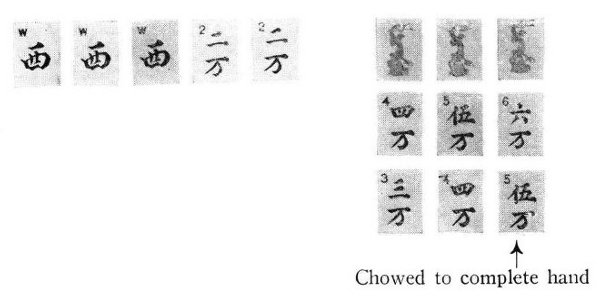
Example No. 19
[Pg 45]PLAYER IS WEST WIND
| Mah-Jongg | 20 | |
| 20 | ||
| 3 winds (concealed) | 8 | |
| 3 dragons (exposed) | 4 | |
| 32 | ||
| Double once for all one suit except winds or dragons | 64 | |
| Double once for white dragons | 128 | |
| Double once for own wind | 256 |
Collects 512 from East wind, 256 from North and South, respectively.
PLAYER IS EAST WIND
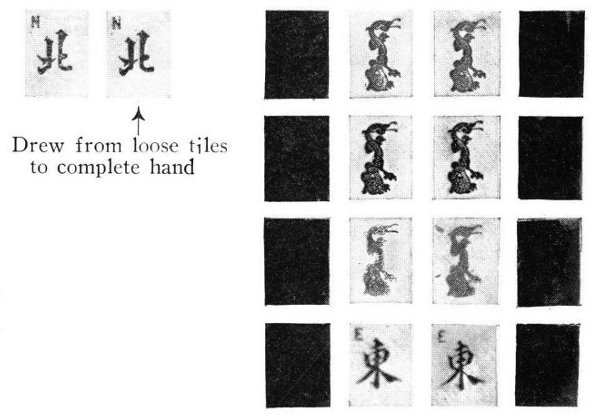
Example No. 20
| Mah-Jongg | 20 | |
| No sequence | 10 | |
| Winning on loose tile draw | 10 | |
| Drawing winning piece | 2 | |
| Filling only place to win | 2 | |
| 44 | ||
| 4 dragons (concealed) | 32 | |
| 4 dragons (concealed) | 32 | |
| 4 dragons (concealed) | 32 | |
| 4 winds (concealed) | 32 | [Pg 46] |
| 172 | Total Score | |
| Double 3 times for all of one suit (honor) | 344 | |
| 688 | ||
| 1376 | ||
| Double once for green dragons | 2752 | |
| Double once for white dragons | 5504 | |
| Double once for red dragons | 11008 | |
| Double once for own wind | 22016 | |
| Double once because everyone must pay East wind double when he wins | 44032 | Final Score |
East wind collects this amount from each of the other three players, making a total of 132,096 points that East may win in one hand. This is the highest hand which is probable. There is a hand composed of sets of 3 of a kind, similar to this, which, if drawn on the original draw, will yield more points than this, but it is highly improbable that the hand will ever actually be drawn by any given player.
In the four layouts following, the illustrations represent all the hands together as they are laid down after one of the players wins. They serve to clear up "settling" of the scores and also bring out important points in the playing of the hands. In each case the score of the four players is given in total and practice in the calculating of scores can be obtained by beginners by scoring these hands and comparing their results with the given scores.
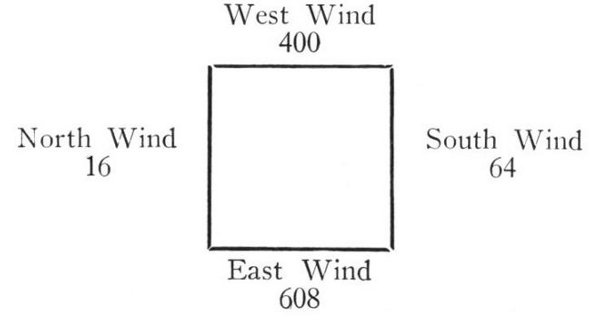
East Wind "Mah-Jongged" with a total score of 608 points. He collects double this amount from each of the other three winds because he is East Wind, and winning, collects double. This makes 1216 from each player or a total of 3648. He then throws his hand into the discard and the other three players settle, the high hand collecting the difference between his hand and the remaining two. In the illustration, West Wind is the high hand and he collects 336 from South Wind and 484 from North Wind, the difference between his hand and those of South and North Winds, respectively. He then discards his hand and leaves the South and North Winds to settle. They do this by South Wind collecting 48 points from North; both discard their tiles, and the scores are settled. It might be best here to analyze the above layout to see how the play went. East Wind's hand appeared harmless enough because he had most of it concealed, only exposing two sets. On this account, none of the other opponents would hesitate about discarding the eight of bamboo which allowed him to Mah-Jongg. North and South Winds having poor hands themselves might have held the eight of bamboo and not have taken a chance on it "putting him out" if they had been warned how near he was to winning, for West Wind had an exceptionally fine hand with the best part of it concealed and he won back from North and South Winds more than half of his payment to East, the winner.
North and South Winds fell in a conflict of suits, one of the most frequent occurrences of the game and one which spoils a great many otherwise good hands. They were both attempting to complete "all dot" hands and each has two conflicting pairs, namely, 5 and 6 of dots. Either of them to win can only have one pair in their hand, and each was holding the other from any chance of winning.
When two players play for the same suit, it is best for both to give up any idea of obtaining all of one suit, and fill in the hand with one or two sets of winds or dragons. Very often one can get three doubles in this way when it would be impossible to complete a hand of all one suit.
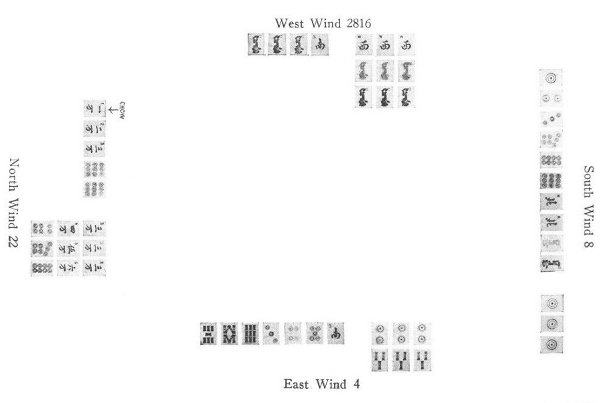
NORTH WIND MAH-JONGGS
North Wind Mah-Jonggs with 22 points as his total score. He collects 22 points apiece from North Wind and South Wind. East, however, must pay him double or 44, being banker and losing. This gives North Wind a total of 88. The other three then settle. West Wind with a total of 2816; collects the difference between his hand and East Wind's which is 2814, doubled because he won from East Wind and East Wind must pay double when he loses. This gives West Wind 5628 from East Wind, and just the difference in their hands from South Wind which is 2808. Then South Wind in settling with East Wind collects the difference, 4, double or 8. This layout demonstrates the point that it is not always necessary to Mah-Jongg or win, in order to take in the highest number of points. North Wind "Mah-Jongged" and collected only 88 points, whereas West Wind collected a total of 8,436 points. What evidently took place in this hand goes as follows: West Wind was exceptionally fortunate in the draw and soon had three sets of winds and dragons exposed, or on the table. The other three players seeing in this a dangerous hand, "ran for cover," this consisting of gathering all the sequences possible together, and mixing the suits. By doing this a player can very quickly complete his hand and win, although his score will be low when he does win. However, the one who does "Mah-Jongg," no matter how low his score may be, collects that amount, and escapes any exceptionally high scoring hands which the other players may hold. In this case it was North Wind who won out and avoided paying many points to West Wind by doing so.
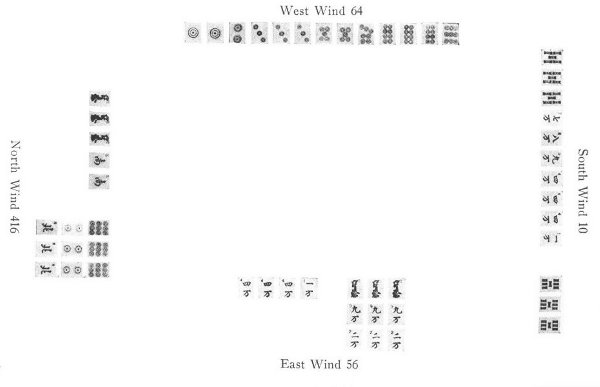
NORTH WIND MAH-JONGGS
In the above layout, North Wind winning, scores 416; West Wind 64; South Wind 10, and East Wind 56; North Wind then takes 832 from East Wind, and 416 from West and South Winds. West Wind collects 54 from South Wind and 16 from East Wind; East Wind then collects 46 doubled or 92 from South Wind.
In this game both North and West Winds played for all dot hands; North Wind foreseeing this early in the game filled in his hand with winds and dragons, in this way winning out over West Wind; East Wind starting with a pair of green dragons kept them until he had all characters except the pair. Then came the time for him to decide on whether he would discard the pair and try to fill an all character hand, or use the dragons. He decided on the latter because looking at North Wind's exposed tiles he saw that North Wind was dangerously near to winning. He filled his dragons and attempted to win as quickly as possible, almost succeeding and needing only one tile to complete his hand.
NORTH WIND MAH-JONGGS
North Wind "Mah-Jongged," collects 304 from East and 152 from West and South respectively. Then—East Wind collects 16 doubled or 32 from West and 32 doubled or 64 from South. West Wind wins 16 from South who is the loser all around. East Wind's difficulty above was that he decided on all bamboo hand at the start of the game without having a sufficient number of pairs in that suit. The result was that by the time that he drew the pairs and was ready to pung discards the other players had already discarded a number of tiles which he needed in his hand. They were then dead. The result of all this can be seen in his hand above; he has still two pairs and a sequence to fill and the particular tiles needed to do this (the 4, 5 and 8 of bamboo) have probably all been discarded early in the game by the other players. The point thus illustrated being: It is not advisable to attempt the completing of a suit which all the other players are discarding unless sufficient pairs are held from the start to withstand their attacks.
Pung-Chow, as it has been described in the foregoing pages, represents the game as it is played with unlimited hands, that is where no limits are set on the number of points permissible in the score of a hand. It is impractical, however, to play with unlimited hands in a game where a stake has been set due to the inconsistencies of the winning hand scores; one may win with a hand of 200,000 points, whereas the ordinary or average winning hand numbers approximately only 500 to 1,000.
On this account the Chinese use a lower scoring system and set limits on the hands whenever placing stakes on the game, with a view of limiting losses between all players.
This setting of a limit changes the game considerably, for while the procedure of the play is similar to that of the unlimited hand, the scoring is almost totally different and the actual playing of the hand is changed.
A player in a limited hand gains nothing by completing a hand scoring high in the thousands when held down to the limit which is comparatively low. This changes entirely the playing of hands, making each player's object no longer to score as high a hand as possible and win, but to score as closely to the limit as possible and win, which in practice amounts to completing the hand as quickly as possible, mixing sequences and sets of all suits and taking all good scoring sets as they come, planning for none.
It can be seen that there is a larger element of fortune or "luck" in this method of playing than there is in playing the unlimited hand, though in either case the best player will win consistently.

In playing this sort of a game the wind indicators in their container, the Cheung Huen or wind box, are always used, and their use changes the method of commencing the game.
To start the game when using the wind markers the seats are preliminarily chosen and any one of the four players throws the two dice once, the result of this throw deciding which player is to throw again for playing position. Counting of players being done in a counter-clockwise direction as previously explained.
The players thus designated will shuffle the wind indicators thoroughly face downward and places any one of them still face downward on top of wind box. He then arranges the whole lot in a perpendicular straight line in front of them all face downward, placing the box with the wind indicator still on top of it in any order he pleases. (See Illustration No. 1.)

Illustration No. 1
In this illustration, C first threw the dice; the number was seven, deciding A as the player who was to throw again for playing position or seat. A has shuffled the markers and arranged them perpendicularly in front of him, placing the wind box in second position. He had the privilege of placing it in 1st, 3rd or 4th position if he had chosen. He then throws with the dice, an 8; this designates D as the player to take the first indicator; A the second (also the wind box), B the third, and C the fourth.
He then throws the two dice and the number thrown will decide which player is to pick up the indicator farthest from him (or the first indicator in the accompanying illustration) counting in the usual manner one player at a time in counter-clockwise direction, starting with himself as 1. The player indicated will pick up the first indicator, the player on his right the second indicator, the player opposite the third and the player to his left the east.
The wind box goes to the player picking up the indicator on top of it who then places it in front of him to mark the seat of East Wind. The players then look at their indicators; the one drawing the East Wind indicator becomes East Wind, and occupies the seat marked by the wind box. The remaining three players seat themselves about the table according to their draw or wind marker, i.e., draw of West Wind indicator opposite to East, North Wind to the left and South Wind to the right of him (East).
East Wind now takes charge of the wind box and the four indicators which are placed in the wind box face up with East Wind on top. The East Wind player retains the box until he loses a hand. When this occurs the box goes to the right to the player who was South, but now becomes East Wind. The East Wind indicator, however, still remaining on top as this designates that the East Wind round is being played. The East Wind round is over as soon as the fourth player to be East Wind in turn loses. He is the one to take charge of the East Wind indicator and placing the South Wind indicator on top to indicate the South Wind round, hands the box to the original East Wind who now becomes the first East Wind of the South Wind round. It will now be seen that four games make up a round and four rounds make up a set. In every case the new wind-round must commence from the original East Wind player and the box is for the purpose of indicating which round of the wind is being played and who is the East Wind in that particular hand.
It should be decided before starting how many sets are to be played. Chinese players generally play from 4 to 8 sets in an evening.
The seats having been chosen and winds positioned, the procedure of play continues exactly as has been described before. The wall is broken and the tiles drawn in the same manner, "Chowing," "Punging" and filling four of a kind are processes gone about in the same manner as they are in the other type of game.
Mah-Jongg also is attained in the same way, i.e., completing four sets and a pair.
Almost the entire difference in the two ways of playing the game is found in the scoring.
In the scoring many new combinations have been added, scoring values have been changed, and special bonuses, limit hands and new doubling honors have been introduced which must now be taken, one at a time, and explained in detail. The most important change is that the last 14 tiles in the wall are never drawn and the game ends and is a draw if it reaches this point without conclusion.
Loose tiles may be drawn of course during the play, but even a loose tile cannot be drawn if there are only 14 tiles left in the wall including the loose tiles. These last 14 tiles are usually separated a little from the rest of the wall to indicate the end.
To keep the hands down to a reasonable amount when players are playing for stakes, the system of setting a limit as to the number of points that can be scored in a hand. This is usually 300 points; in games giving a bonus of 10 points for Mah-Jongg, and 400 in games giving a bonus of 20 points for Mah-Jongg. East Wind of course is liable for double the limit and at the same time may win as high as double the limit from each player. To non-winners settling their scores, settle the difference in the score up to the limit if neither is East Wind, and up to double the limit if either is East Wind.
The limit is of course entirely optional, and may be set by the players at the beginning of the play. A limit of 600 points between players seems the most popular at present in America.
It is necessary before going into "Washing the Tiles" to explain the meaning of "Heads." A Head is a one, nine, wind or a dragon, and a hand containing 9 or more different "Heads" on the original hand drawn from the wall entitles the player to "Wash Tiles." He calls out "no play" and exposes his hand, collecting according to the following table:
From each player
| 9 Heads | 50 points |
| 10 Heads | 70 points |
| 11 Heads | 100 points |
| 12 Heads | 150 points |
| 13 Heads | 200 points |
When washing the tiles takes place, the tiles must be reshuffled and the wall built over. East Wind retains the "Cheung" (wind box) and not collecting double when he "washes tiles" does not have to pay any of the other players double when they "wash tiles." It must be remembered that in order to wash the tiles the heads must be different, that the hand must be the original 13 tiles (14 in case of East Wind) and no drawing is permitted.
1. For Mah-Jongg or completing a hand a bonus is given and this is generally 10 points unless specially agreed upon to be so.
2. For winning hand of absolutely no scoring value than Mah-Jongg, 10 points is given as a bonus.
3. For winning tile drawn by the player himself from the last tile which may be drawn in the wall doubles the total score once (i.e., the 15th tile from the end of the wall).
4. Winning on a draw from a loose tile doubles total score once.
5. To win on first card played a bonus of half the limit hand is given. Washing cards have preference over this wind.
6. For completing the hand with the fourth card of an exposed set of three of a kind—for example, if a player has an exposed set of 3 of a kind and he draws or pungs the fourth tile, and if this very tile is the winning tile, he may double the total score once.
A player holding a winning hand of any one of the following combinations receives from each of the players the full amount agreed upon.
1. A winning hand of single heads one only of each with a pair of heads different from the rest representing the final pair.

Illustration No. 2
2. A winning hand containing sets of heads only with a pair of heads as the final pair.

Illustration No. 3
3. A winning hand of four different sets of winds and any kind of a final pair. In China this hand is called the four happinesses and superstition has it that one holding this hand has much good fortune coming to him having the four happinesses at his door.

Illustration No. 4
4. The winning hand of 3 different sets of winds with a pair of the other winds as the final pair.
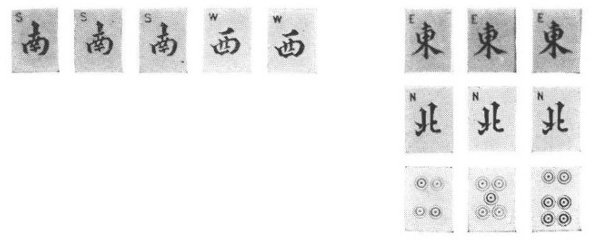
Illustration No. 5
5. A winning hand made up entirely of sets of four of a kind with any pair as the final pair.
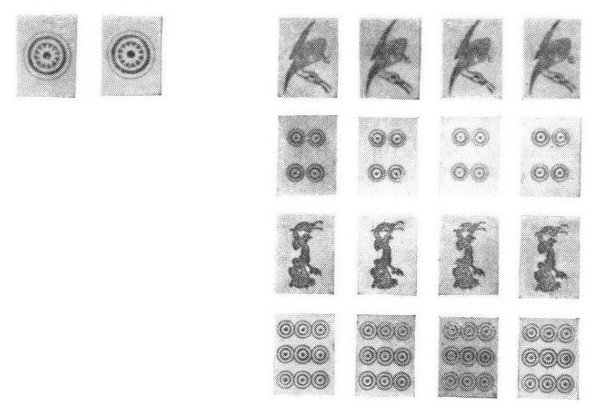
Illustration No. 6
6. East Wind winning on original draw from the wall. This wind has preference over washing cards. The Chinese consider this hand as a forecast of misfortunes to come.
7. A winning hand containing the 3 sets of dragons; red, green and white. In China these are known as the 3 Doctors of Literature. The inference of course being that many tiles must be turned away before these three sets can be made up just as many students in China are turned away by competitive examinations before the three best scholars are chosen to pursue their studies at the Royal Court with the title of Doctors of Literature.
| [A]Winning Hand. | ||
| Mah-Jongg | 10 Points | |
| No other score in hand or on table than Mah-Jong | 10 Points | |
| On Table | In Hand | |
| Of three of a kind of 2 to 8 | 2 | 6 |
| Of three of a kind of heads | 4 | 10 |
| Of four of a kind 2 to 8 | 8 | 16 |
| Of four of a kind of heads | 16 | 32 |
| Pair of 2 to 8 punged to complete hand | 0 | 2 |
| Pair of 2 to 8 drawn to complete hand | 0 | 4 |
| Pair of heads punged to complete hand | 0 | 4 |
| Pair of heads drawn to complete hand | 0 | 6 |
| Pair of the player's own wind punged by him in his own wind round to complete hand | 0 | 6 |
| Pair of the player's own wind drawn by him in his own wind round to complete hand | 0 | 8 |
| Filling a sequence in the middle on the only open end to complete hand | By Chow | 2 |
| Filling a sequence with both ends open by draw to complete hand | By Draw | 4 |
[A] Count for winning hand only.
| Other Hands | On Table | In Hand |
| Three of a kind of 2 to 8 | 2 | 4 |
| Three of a kind of heads | 4 | 8 |
| Four of a kind 2 to 8 | 8 | 16 |
| Four of a kind heads | 16 | 32 |
| One pair of a kind any dragon | . . | 2 |
| One pair of own wind | . . | 2 |
| One pair of wind of the round | . . | 2 |
| One pair of players own wind in the wind of his own wind round | . . | 4 |
1. Pair of 2-8 punged to complete hand. A player must have four sets and a pair to win. The above scoring value is given if the pair is from 2 to 8 and if he pungs one of them to win.
2. Pair of 2-8 drawn to complete hand. This score is given as above when the player's extra pair is from 2-8, but he must match the pair by draw.
3. Pair of heads punged to complete hand. This four points is given when player pungs to match his final pair.
4. Pair of heads drawn to complete hand. This six points is given when player draws and matches his final pair.
5. Pair of player's own wind punged by him in his own wind round to complete his hand. This six points is given to a player who "pungs" to match this final pair when his final pair is his own wind and it is his own wind round.
6. Pair of the player's own wind in his own wind round drawn by him to complete his hand. This is similar to the one above except that the player draws the tile instead of punging it, thereby getting 8 points instead of 6 points.
7. Filling a sequence in the middle or on the only open end to complete hand. An example would be chowing a 6 character, have a 5 character and a 7 character, or have the 2 and chowing the 3 (only open end).
Filling a sequence with both ends open, by draw to complete hand. An example would be, having a 7 and 8 of character and drawing a 6 or a 9. In both this and the above case when the sequence is filled by draw, it must immediately be set out face up on the table to the right of player, with the draw tile drawn on top of the other two according to the illustration.
1. A set of a player's own wind doubles his total score once.
2. A set of a player's own wind in his own wind round doubles his total score twice.
3. A set of red dragons doubles his total score once.
4. A set of green dragons doubles his total score once.
5. A set of white dragons doubles his total score once.
[B]6. A hand of all one suit except winds or dragons doubles his total score once.
[B]7. A winning hand having no sequences in it doubles the total score once. This hand is known as "Tei Tei Woo" (mixed sets or no sequences) among the Cantonese Chinese.
[B]8. A winning hand entirely of one suit, doubles the total score three times.
[B] Count for winning hand only.
1. In the event of a player announcing Mah-Jongg when his hand is not complete, the player making the error must pay to each of the other 3 players half of the limit. East Wind receiving full limit or paying full limit as the case may be.
2. The one discarding a tile that permits another player to win must bear the entire losses of all other players; if the player winning had any of the following four combinations of tiles exposed at the time of discarding, unless the discarder himself had two complete doubling honors and was waiting for the winning tile or was waiting for the winning tile which would give him more than two doubling honors.
1. When nine tiles or more of the same suit are exposed and the discarded tile gives a winning hand on entirely one suit.
2. When nine heads or more are exposed and the discarded tile gives a winning hand of entirely heads.
3. When two sets of dragons are exposed and the discard of the other kind of dragon gives the third set of dragon in a winning hand.
4. When three different sets of winds are exposed and the discard of the other wind gives a winning hand.
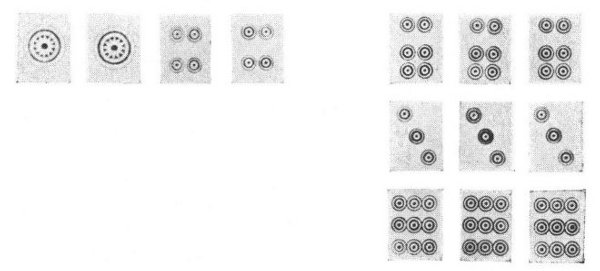
Illustration No. 8a
Example 1. Any player discarding a one or a four of dot would complete this hand and unless he had two complete doubling honors and was waiting for the winning card or was waiting for the winning card to complete his hand, with more than 2 doubling honors, he must pay the winner for all.
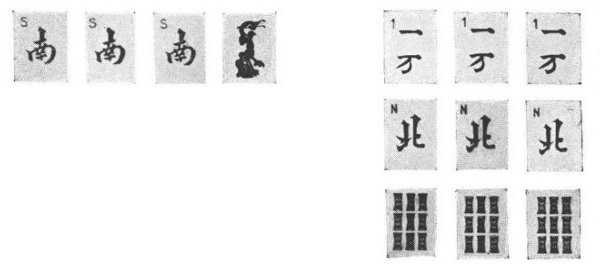
Illustration No. 8b
Example 2. Any player discarding a red dragon will permit this player to win and will be penalized for his recklessness by having to pay all scores, unless his own hand fulfills the requirements set out in Example No. 1.
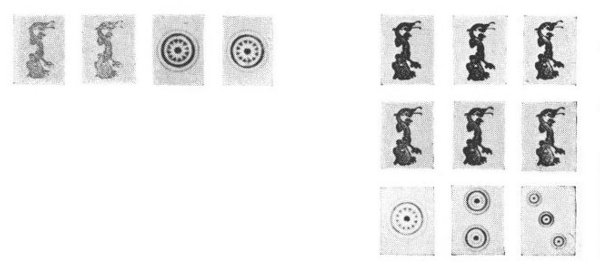
Illustration No. 8c
Example 3. A player discarding a white dragon is liable to the penalty above mentioned, unless his own hand fulfills the requirements given above in No. 1; anyone may discard a one of dot which, though permitting the player with the above hand to win, would not bring a penalty down upon the discarder.
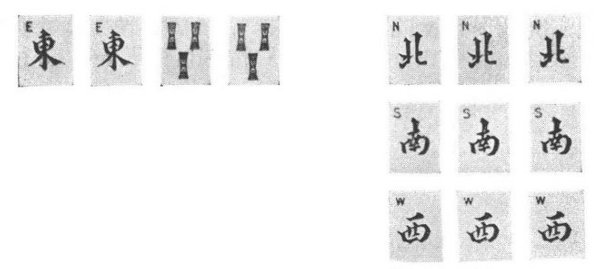
Illustration No. 8d
Example 4. A player discarding an East Wind would allow this player to win and would be penalized unless excepted as in the other examples. Here as in Ex. 3, a discard to the other pair, i.e., a three of bamboo, would not be penalized.
NOTE. (a) If a player has no choice in his discard; that is if he discards the winning dot to an all dot hand when he has only dots to discard, he is not penalized.
(b) When a penalty is imposed, all scores except that of the winning hand are canceled.
Note: Arrow indicates tile which completed the hand in the following Examples.

No. 1
Player is East Wind; South Wind round.
| Mah-Jongg | 10 | |
| Three 8 character (concealed) | 6 | |
| Three 3 bamboo (concealed) | 6 | |
| Three Heads (1 dot) (concealed) | 10 | |
| Three 5 character (exposed) | 2 | |
| Pair of Heads drawn (1 character) | 6 | |
| 40 | Total Score | |
| For no sequences double once | 80 | Total Score |
| East Wind collects double if winning double once | 160 | From each player |

No. 2
Player is North Wind in North Wind round.
| Mah-Jongg | 10 | |
| Three of Heads (9 character) (concealed) | 10 | |
| Three of Heads (North Wind) (concealed) | 10 | |
| Three Bamboo (concealed) | 6 | |
| Three of Heads (Red Dragon) (exposed) | 4 | |
| 40 | ||
| For three red dragons double once | 80 | |
| For three of own wind in own wind round double twice | 160 | |
| 320 | ||
| For no sequence double once | 640 |
Player would collect 1280 from East Wind and 640 from other two winds. If his score 640 were over the limit he would collect double the limit from East and only the limit from South and West respectively.
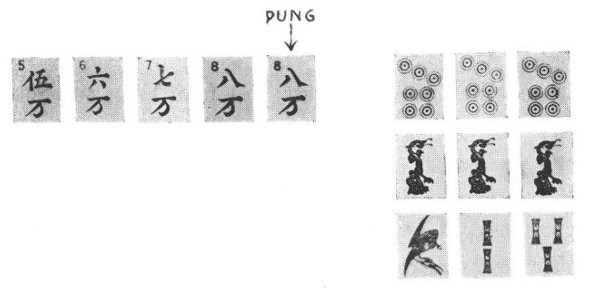
No. 3
North Wind—East Wind round.
| Mah-Jongg | 10 | |
| Three Heads (red dragon) (exposed) | 4 | |
| Three 7 character (exposed) | 2 | |
| 26 | ||
| For three red dragons double once | 52 |
Player collects 104 from East Wind; 52 from South and West.

No. 4
Player is North Wind in East Wind Round.
| Mah-Jongg | 10 | |
| Three of Heads (red dragons) (exposed) | 4 | |
| Three of Heads (green dragons) (concealed) | 10 | |
| Three of Heads (nine bamboo) (concealed) | 10 | |
| Three of bamboo (concealed) | 6 | |
| Completing pair of player's own wind in his own wind round by draw | 8 | |
| 48 | ||
| For no sequences double once | 96 | |
| For three red dragons double once | 192 | |
| For three green dragons double once | 384 | Final Score |
Players collect 768 from East; 384 from West and South.

No. 5
Winning hand of "Single Heads." One of the "Limit" Hands, player collecting double the limit from East and only the limit from the others.
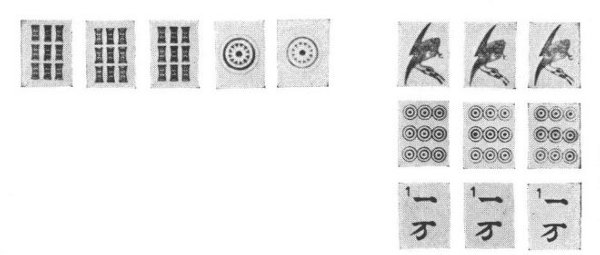
No. 6
Winning hand containing sets of heads only; this is a "Limit Hand," winner collecting double the limit from East and only the limit from the other two players.
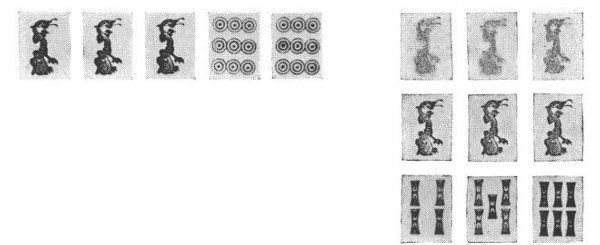
No. 7
Winning hand containing all three sets of dragons and any other set and pair. This is a "Limit Hand," winner collecting double from East and the limit from the other two players. In all limit hand cases, East Wind, if winner, collects double limit from All players.

No. 8
Player is South Wind in South Wind Round.
| Mah-Jongg | 10 | |
| Three Heads (white dragons) (concealed) | 10 | |
| Three 4 dot (exposed) | 2 | |
| Three Heads (9 dot) (exposed) | 4 | |
| Filling sequence in middle by draw to win | 4 | |
| Pair of own wind in own wind round | 4 | |
| 34 | Total Score | |
| For three white dragons double once | 68 | |
| For all one suit except winds and dragons double once | 136 | Final Score |
Players collect 272 from East, 136 from North and West.
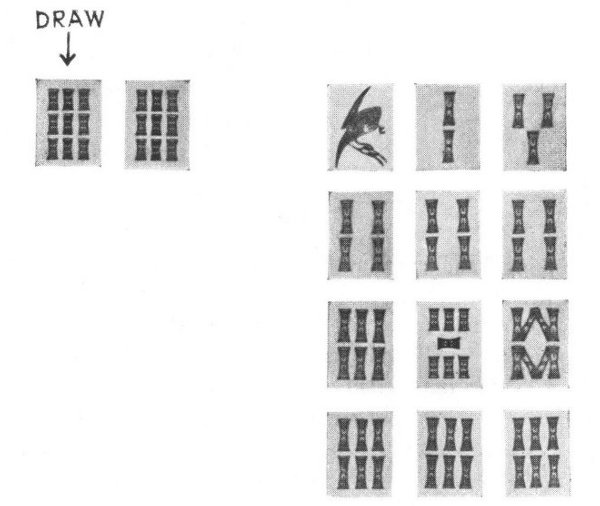
No. 9
Player is East Wind in South Wind round.
| Mah-Jongg | 10 | |
| Three 4 bamboo (exposed) | 10 | |
| Three 6 bamboo (exposed) | 2 | |
| Pair of Heads, completed by draw | 4 | |
| 20 | Total Score | |
| For all one suit double three times | 40 | |
| 80 | ||
| 160 | Final Score |
Double because East Wind collects double when winning 320 from each player.
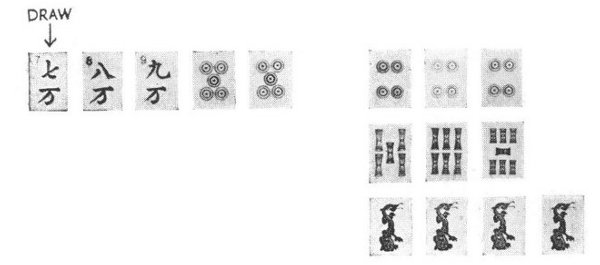
No. 10
Player's West Wind—East Wind round.
| Mah-Jongg | 10 | |
| Four Heads (red dragons) (exposed) | 16 | |
| Three 4 characters (exposed) | 2 | |
| Filling a sequence on the only open end | 4 | |
| 32 | Total Score | |
| For four red dragons double once | 64 | Final Score |
Player collects 128 from East and 64 from West and South.
Three or even two may play Pung Chow, though the game is essentially a four-handed affair. It is played by two or three people in exactly the same way that it is played by four, each player building up his own side of the wall and then combining to build the fourth side.
This fourth side is regarded as the dummy wall. In the building and breaking down of the wall, East Wind acts for the dummy, throwing the dice for it whenever indicated. The three players then draw their original hand and ignore the dummy the rest of the game, playing in regular routine and omitting the dummy's turn of play.
When two play alone, each builds two sides of the wall and arrange the usual wall. Then they throw the dice, East Wind throwing for either of the two dummies, both draw their original hands and draw and discard alternately until one wins.
Of course when two or three play there is less opposition or conflict and far greater possibilities in the draw than in the four-handed game. On this account, higher scores are the rule rather than the exception, making a more exciting and entertaining game but hardly one upon which stakes could be safely set.
| PART I | |
| Playing Without a Limit | |
| Introduction | 7 |
| Summary of the Game | 9 |
| Description of Tiles | 11 |
| Procedure of Play | 13 |
| A—East Wind | 13 |
| B—Building and Breaking the Wall | 13 |
| C—Drawing Original Hand | 16 |
| D—Playing the Hand | 16 |
| E—To "Chow" | 18 |
| F—To "Pung" | 19 |
| Four of a Kind | 22 |
| Mah-Jongg or Mah-Diao | 24 |
| Settling the Scores | 25 |
| Suggestions for Careful Playing of Hands | 26 |
| Use of the Mandarins (Flowers and Seasons) | 29 |
| Score Card | 29 |
| Examples of Hands and how they are scored | 32 |
| Illustrations of Score Settling | 46 |
| PART II | |
| Playing with a Limit | 56 |
| Procedure of Play | 57 |
| A—The limit hand | 60 |
| B—Washing the tiles | 61 |
| Bonus Scores | 62 |
| Limit Hands | 62 |
| Scoring Values | 65 |
| Explanation of Scoring Values | 66 |
| Doubling Honor Scores | 67 |
| Penalties | 67 |
| Examples of Winning Hands | 70 |
| Two and Three-Handed Games | 76 |
Pung-Chow
The Game of A Hundred Intelligences

The game which is rapidly replacing bridge and other card games, as well as other forms of indoor pastimes.
Pung Chow is an American product differing from the imported sets only in the following points:
It is more pleasing to the eye and the touch.
The beautiful Oriental colors are fast and cannot rub off, even though the pieces be scrubbed with soap and water.
The pieces will not become sticky from the moisture of the hand.
Pung Chow pieces are not affected by the climate and will never work loose.
Should one or more pieces be lost they may be easily and quickly replaced.
Pung Chow is an article of beauty and quality and is practically indestructible.
Manufactured by
PUNG CHOW CO., Inc.
30 Church Street, New York City
Page 24. The concealed One of Circle in illustration 15 should be a One of Bamboo.
Page 34. Two points should be scored for a pair of Dragons in Example 3.
Page 36. In Example 7 the three Dragons completed by a pung should be exposed at right with the other three sets.
Page 41. Two points should be scored for a pair of Dragons in Example 14.
Page 42. At top of page, "Drew to complete hand" should read "Punged to complete hand."
Page 44. In Example 18 the three Dragons completed by a pung should be exposed at right with the other three sets. In the same example "3 Dragons (concealed) ... 8" should read "3 Dragons (exposed) ... 4."
Page 46 and 47. East Wind scores 480 instead of 608; West Wind scores 272 instead of 400.
Page 47. All Character tiles in hand of West Wind should be Bamboo tiles.
Page 48. Lines 19 and 21 "Eight of Bamboo" should read "Eight of Character."
Page 49. West Wind scores 2562 instead of 2816.
Page 53. In North Wind hand the three Sevens of Circles should be exposed instead of in hand.
Page 54. Lines 1 and 2. Read "368" instead of "304," and "184" instead of "152."
Page 72. Example 3. "26" and "52" should read "16" and "32" respectively. Example 4. Player is East Wind instead of North Wind.
The Errata page above is transcribed from the original text. As it is not possible to correct some of these errors without also altering subsequent entries in the scoring examples, none of the errors have been corrected in this version of the book.
Punctuation and capitalization have been normalized, and the following obvious typographical errors in the original text have been corrected:
Page 13. "South Wind, and the the left of" changed to "South Wind, and the left of."
Page 15. "if 14 in the sum" changed to "if 14 is the sum."
Page 41. The phrase "Double 3 times for all suit (honor)" changed to "Double 3 times for all one suit (honor)"
Page 70. "If he discard the winning" changed to "if he discards the winning."
Page 72. "For bo sequences double once" changed to "For no sequences double once."
Additionally it is noted that:
Page 50. The phrase "22 points apiece from North" should likely read "22 points apiece from West."
Page 62. The phrase "Washing cards have preference over this wind" should possibly read either "Washing cards ... this hand" or "Washing cards ... this win."
Page 64. The phrase "this wind has preference" should possibly read either "this hand has preference," or "this win has preference."
Page 66. The phrase "the 2 and chowing the 3" should likely read "the 1 and 2 and chowing the 3."
Page 72. The phrase "Players collect 768 from" should likely read "Player collects 768 from."
Page 74. The phrase "Players collect 272 from" should likely read "Player collects 272 from."
There are a number of inconsistencies between the Chapter Headings and the Table of Contents. These have not been corrected.
In Part II, the numbering of illustrations is non-continuous: there is no Illustration No. 7 in the original.
***END OF THE PROJECT GUTENBERG EBOOK PUNG CHOW***
******* This file should be named 27318-h.txt or 27318-h.zip *******
This and all associated files of various formats will be found in:
http://www.gutenberg.org/2/7/3/1/27318
Updated editions will replace the previous one--the old editions will be renamed.
Creating the works from public domain print editions means that no one owns a United States copyright in these works, so the Foundation (and you!) can copy and distribute it in the United States without permission and without paying copyright royalties. Special rules, set forth in the General Terms of Use part of this license, apply to copying and distributing Project Gutenberg-tm electronic works to protect the PROJECT GUTENBERG-tm concept and trademark. Project Gutenberg is a registered trademark, and may not be used if you charge for the eBooks, unless you receive specific permission. If you do not charge anything for copies of this eBook, complying with the rules is very easy. You may use this eBook for nearly any purpose such as creation of derivative works, reports, performances and research. They may be modified and printed and given away--you may do practically ANYTHING with public domain eBooks. Redistribution is subject to the trademark license, especially commercial redistribution.
*** START: FULL LICENSE ***
THE FULL PROJECT GUTENBERG LICENSE
PLEASE READ THIS BEFORE YOU DISTRIBUTE OR USE THIS WORK
To protect the Project Gutenberg-tm mission of promoting the free
distribution of electronic works, by using or distributing this work
(or any other work associated in any way with the phrase "Project
Gutenberg"), you agree to comply with all the terms of the Full Project
Gutenberg-tm License (available with this file or online at
http://www.gutenberg.org/license).
Section 1. General Terms of Use and Redistributing Project Gutenberg-tm
electronic works
1.A. By reading or using any part of this Project Gutenberg-tm
electronic work, you indicate that you have read, understand, agree to
and accept all the terms of this license and intellectual property
(trademark/copyright) agreement. If you do not agree to abide by all
the terms of this agreement, you must cease using and return or destroy
all copies of Project Gutenberg-tm electronic works in your possession.
If you paid a fee for obtaining a copy of or access to a Project
Gutenberg-tm electronic work and you do not agree to be bound by the
terms of this agreement, you may obtain a refund from the person or
entity to whom you paid the fee as set forth in paragraph 1.E.8.
1.B. "Project Gutenberg" is a registered trademark. It may only be
used on or associated in any way with an electronic work by people who
agree to be bound by the terms of this agreement. There are a few
things that you can do with most Project Gutenberg-tm electronic works
even without complying with the full terms of this agreement. See
paragraph 1.C below. There are a lot of things you can do with Project
Gutenberg-tm electronic works if you follow the terms of this agreement
and help preserve free future access to Project Gutenberg-tm electronic
works. See paragraph 1.E below.
1.C. The Project Gutenberg Literary Archive Foundation ("the Foundation"
or PGLAF), owns a compilation copyright in the collection of Project
Gutenberg-tm electronic works. Nearly all the individual works in the
collection are in the public domain in the United States. If an
individual work is in the public domain in the United States and you are
located in the United States, we do not claim a right to prevent you from
copying, distributing, performing, displaying or creating derivative
works based on the work as long as all references to Project Gutenberg
are removed. Of course, we hope that you will support the Project
Gutenberg-tm mission of promoting free access to electronic works by
freely sharing Project Gutenberg-tm works in compliance with the terms of
this agreement for keeping the Project Gutenberg-tm name associated with
the work. You can easily comply with the terms of this agreement by
keeping this work in the same format with its attached full Project
Gutenberg-tm License when you share it without charge with others.
1.D. The copyright laws of the place where you are located also govern
what you can do with this work. Copyright laws in most countries are in
a constant state of change. If you are outside the United States, check
the laws of your country in addition to the terms of this agreement
before downloading, copying, displaying, performing, distributing or
creating derivative works based on this work or any other Project
Gutenberg-tm work. The Foundation makes no representations concerning
the copyright status of any work in any country outside the United
States.
1.E. Unless you have removed all references to Project Gutenberg:
1.E.1. The following sentence, with active links to, or other immediate
access to, the full Project Gutenberg-tm License must appear prominently
whenever any copy of a Project Gutenberg-tm work (any work on which the
phrase "Project Gutenberg" appears, or with which the phrase "Project
Gutenberg" is associated) is accessed, displayed, performed, viewed,
copied or distributed:
This eBook is for the use of anyone anywhere at no cost and with
almost no restrictions whatsoever. You may copy it, give it away or
re-use it under the terms of the Project Gutenberg License included
with this eBook or online at www.gutenberg.org
1.E.2. If an individual Project Gutenberg-tm electronic work is derived
from the public domain (does not contain a notice indicating that it is
posted with permission of the copyright holder), the work can be copied
and distributed to anyone in the United States without paying any fees
or charges. If you are redistributing or providing access to a work
with the phrase "Project Gutenberg" associated with or appearing on the
work, you must comply either with the requirements of paragraphs 1.E.1
through 1.E.7 or obtain permission for the use of the work and the
Project Gutenberg-tm trademark as set forth in paragraphs 1.E.8 or
1.E.9.
1.E.3. If an individual Project Gutenberg-tm electronic work is posted
with the permission of the copyright holder, your use and distribution
must comply with both paragraphs 1.E.1 through 1.E.7 and any additional
terms imposed by the copyright holder. Additional terms will be linked
to the Project Gutenberg-tm License for all works posted with the
permission of the copyright holder found at the beginning of this work.
1.E.4. Do not unlink or detach or remove the full Project Gutenberg-tm
License terms from this work, or any files containing a part of this
work or any other work associated with Project Gutenberg-tm.
1.E.5. Do not copy, display, perform, distribute or redistribute this
electronic work, or any part of this electronic work, without
prominently displaying the sentence set forth in paragraph 1.E.1 with
active links or immediate access to the full terms of the Project
Gutenberg-tm License.
1.E.6. You may convert to and distribute this work in any binary,
compressed, marked up, nonproprietary or proprietary form, including any
word processing or hypertext form. However, if you provide access to or
distribute copies of a Project Gutenberg-tm work in a format other than
"Plain Vanilla ASCII" or other format used in the official version
posted on the official Project Gutenberg-tm web site (www.gutenberg.org),
you must, at no additional cost, fee or expense to the user, provide a
copy, a means of exporting a copy, or a means of obtaining a copy upon
request, of the work in its original "Plain Vanilla ASCII" or other
form. Any alternate format must include the full Project Gutenberg-tm
License as specified in paragraph 1.E.1.
1.E.7. Do not charge a fee for access to, viewing, displaying,
performing, copying or distributing any Project Gutenberg-tm works
unless you comply with paragraph 1.E.8 or 1.E.9.
1.E.8. You may charge a reasonable fee for copies of or providing
access to or distributing Project Gutenberg-tm electronic works provided
that
- You pay a royalty fee of 20% of the gross profits you derive from
the use of Project Gutenberg-tm works calculated using the method
you already use to calculate your applicable taxes. The fee is
owed to the owner of the Project Gutenberg-tm trademark, but he
has agreed to donate royalties under this paragraph to the
Project Gutenberg Literary Archive Foundation. Royalty payments
must be paid within 60 days following each date on which you
prepare (or are legally required to prepare) your periodic tax
returns. Royalty payments should be clearly marked as such and
sent to the Project Gutenberg Literary Archive Foundation at the
address specified in Section 4, "Information about donations to
the Project Gutenberg Literary Archive Foundation."
- You provide a full refund of any money paid by a user who notifies
you in writing (or by e-mail) within 30 days of receipt that s/he
does not agree to the terms of the full Project Gutenberg-tm
License. You must require such a user to return or
destroy all copies of the works possessed in a physical medium
and discontinue all use of and all access to other copies of
Project Gutenberg-tm works.
- You provide, in accordance with paragraph 1.F.3, a full refund of any
money paid for a work or a replacement copy, if a defect in the
electronic work is discovered and reported to you within 90 days
of receipt of the work.
- You comply with all other terms of this agreement for free
distribution of Project Gutenberg-tm works.
1.E.9. If you wish to charge a fee or distribute a Project Gutenberg-tm
electronic work or group of works on different terms than are set
forth in this agreement, you must obtain permission in writing from
both the Project Gutenberg Literary Archive Foundation and Michael
Hart, the owner of the Project Gutenberg-tm trademark. Contact the
Foundation as set forth in Section 3 below.
1.F.
1.F.1. Project Gutenberg volunteers and employees expend considerable
effort to identify, do copyright research on, transcribe and proofread
public domain works in creating the Project Gutenberg-tm
collection. Despite these efforts, Project Gutenberg-tm electronic
works, and the medium on which they may be stored, may contain
"Defects," such as, but not limited to, incomplete, inaccurate or
corrupt data, transcription errors, a copyright or other intellectual
property infringement, a defective or damaged disk or other medium, a
computer virus, or computer codes that damage or cannot be read by
your equipment.
1.F.2. LIMITED WARRANTY, DISCLAIMER OF DAMAGES - Except for the "Right
of Replacement or Refund" described in paragraph 1.F.3, the Project
Gutenberg Literary Archive Foundation, the owner of the Project
Gutenberg-tm trademark, and any other party distributing a Project
Gutenberg-tm electronic work under this agreement, disclaim all
liability to you for damages, costs and expenses, including legal
fees. YOU AGREE THAT YOU HAVE NO REMEDIES FOR NEGLIGENCE, STRICT
LIABILITY, BREACH OF WARRANTY OR BREACH OF CONTRACT EXCEPT THOSE
PROVIDED IN PARAGRAPH F3. YOU AGREE THAT THE FOUNDATION, THE
TRADEMARK OWNER, AND ANY DISTRIBUTOR UNDER THIS AGREEMENT WILL NOT BE
LIABLE TO YOU FOR ACTUAL, DIRECT, INDIRECT, CONSEQUENTIAL, PUNITIVE OR
INCIDENTAL DAMAGES EVEN IF YOU GIVE NOTICE OF THE POSSIBILITY OF SUCH
DAMAGE.
1.F.3. LIMITED RIGHT OF REPLACEMENT OR REFUND - If you discover a
defect in this electronic work within 90 days of receiving it, you can
receive a refund of the money (if any) you paid for it by sending a
written explanation to the person you received the work from. If you
received the work on a physical medium, you must return the medium with
your written explanation. The person or entity that provided you with
the defective work may elect to provide a replacement copy in lieu of a
refund. If you received the work electronically, the person or entity
providing it to you may choose to give you a second opportunity to
receive the work electronically in lieu of a refund. If the second copy
is also defective, you may demand a refund in writing without further
opportunities to fix the problem.
1.F.4. Except for the limited right of replacement or refund set forth
in paragraph 1.F.3, this work is provided to you 'AS-IS,' WITH NO OTHER
WARRANTIES OF ANY KIND, EXPRESS OR IMPLIED, INCLUDING BUT NOT LIMITED TO
WARRANTIES OF MERCHANTIBILITY OR FITNESS FOR ANY PURPOSE.
1.F.5. Some states do not allow disclaimers of certain implied
warranties or the exclusion or limitation of certain types of damages.
If any disclaimer or limitation set forth in this agreement violates the
law of the state applicable to this agreement, the agreement shall be
interpreted to make the maximum disclaimer or limitation permitted by
the applicable state law. The invalidity or unenforceability of any
provision of this agreement shall not void the remaining provisions.
1.F.6. INDEMNITY - You agree to indemnify and hold the Foundation, the
trademark owner, any agent or employee of the Foundation, anyone
providing copies of Project Gutenberg-tm electronic works in accordance
with this agreement, and any volunteers associated with the production,
promotion and distribution of Project Gutenberg-tm electronic works,
harmless from all liability, costs and expenses, including legal fees,
that arise directly or indirectly from any of the following which you do
or cause to occur: (a) distribution of this or any Project Gutenberg-tm
work, (b) alteration, modification, or additions or deletions to any
Project Gutenberg-tm work, and (c) any Defect you cause.
Section 2. Information about the Mission of Project Gutenberg-tm
Project Gutenberg-tm is synonymous with the free distribution of
electronic works in formats readable by the widest variety of computers
including obsolete, old, middle-aged and new computers. It exists
because of the efforts of hundreds of volunteers and donations from
people in all walks of life.
Volunteers and financial support to provide volunteers with the
assistance they need, is critical to reaching Project Gutenberg-tm's
goals and ensuring that the Project Gutenberg-tm collection will
remain freely available for generations to come. In 2001, the Project
Gutenberg Literary Archive Foundation was created to provide a secure
and permanent future for Project Gutenberg-tm and future generations.
To learn more about the Project Gutenberg Literary Archive Foundation
and how your efforts and donations can help, see Sections 3 and 4
and the Foundation web page at http://www.gutenberg.org/fundraising/pglaf.
Section 3. Information about the Project Gutenberg Literary Archive
Foundation
The Project Gutenberg Literary Archive Foundation is a non profit
501(c)(3) educational corporation organized under the laws of the
state of Mississippi and granted tax exempt status by the Internal
Revenue Service. The Foundation's EIN or federal tax identification
number is 64-6221541. Contributions to the Project Gutenberg
Literary Archive Foundation are tax deductible to the full extent
permitted by U.S. federal laws and your state's laws.
The Foundation's principal office is located at 4557 Melan Dr. S.
Fairbanks, AK, 99712., but its volunteers and employees are scattered
throughout numerous locations. Its business office is located at
809 North 1500 West, Salt Lake City, UT 84116, (801) 596-1887, email
business@pglaf.org. Email contact links and up to date contact
information can be found at the Foundation's web site and official
page at http://www.gutenberg.org/about/contact
For additional contact information:
Dr. Gregory B. Newby
Chief Executive and Director
gbnewby@pglaf.org
Section 4. Information about Donations to the Project Gutenberg
Literary Archive Foundation
Project Gutenberg-tm depends upon and cannot survive without wide
spread public support and donations to carry out its mission of
increasing the number of public domain and licensed works that can be
freely distributed in machine readable form accessible by the widest
array of equipment including outdated equipment. Many small donations
($1 to $5,000) are particularly important to maintaining tax exempt
status with the IRS.
The Foundation is committed to complying with the laws regulating
charities and charitable donations in all 50 states of the United
States. Compliance requirements are not uniform and it takes a
considerable effort, much paperwork and many fees to meet and keep up
with these requirements. We do not solicit donations in locations
where we have not received written confirmation of compliance. To
SEND DONATIONS or determine the status of compliance for any
particular state visit http://www.gutenberg.org/fundraising/pglaf
While we cannot and do not solicit contributions from states where we
have not met the solicitation requirements, we know of no prohibition
against accepting unsolicited donations from donors in such states who
approach us with offers to donate.
International donations are gratefully accepted, but we cannot make
any statements concerning tax treatment of donations received from
outside the United States. U.S. laws alone swamp our small staff.
Please check the Project Gutenberg Web pages for current donation
methods and addresses. Donations are accepted in a number of other
ways including checks, online payments and credit card donations.
To donate, please visit: http://www.gutenberg.org/fundraising/donate
Section 5. General Information About Project Gutenberg-tm electronic
works.
Professor Michael S. Hart is the originator of the Project Gutenberg-tm
concept of a library of electronic works that could be freely shared
with anyone. For thirty years, he produced and distributed Project
Gutenberg-tm eBooks with only a loose network of volunteer support.
Project Gutenberg-tm eBooks are often created from several printed
editions, all of which are confirmed as Public Domain in the U.S.
unless a copyright notice is included. Thus, we do not necessarily
keep eBooks in compliance with any particular paper edition.
Each eBook is in a subdirectory of the same number as the eBook's
eBook number, often in several formats including plain vanilla ASCII,
compressed (zipped), HTML and others.
Corrected EDITIONS of our eBooks replace the old file and take over
the old filename and etext number. The replaced older file is renamed.
VERSIONS based on separate sources are treated as new eBooks receiving
new filenames and etext numbers.
Most people start at our Web site which has the main PG search facility:
http://www.gutenberg.org
This Web site includes information about Project Gutenberg-tm,
including how to make donations to the Project Gutenberg Literary
Archive Foundation, how to help produce our new eBooks, and how to
subscribe to our email newsletter to hear about new eBooks.
EBooks posted prior to November 2003, with eBook numbers BELOW #10000,
are filed in directories based on their release date. If you want to
download any of these eBooks directly, rather than using the regular
search system you may utilize the following addresses and just
download by the etext year.
http://www.gutenberg.org/dirs/etext06/
(Or /etext 05, 04, 03, 02, 01, 00, 99,
98, 97, 96, 95, 94, 93, 92, 92, 91 or 90)
EBooks posted since November 2003, with etext numbers OVER #10000, are
filed in a different way. The year of a release date is no longer part
of the directory path. The path is based on the etext number (which is
identical to the filename). The path to the file is made up of single
digits corresponding to all but the last digit in the filename. For
example an eBook of filename 10234 would be found at:
http://www.gutenberg.org/dirs/1/0/2/3/10234
or filename 24689 would be found at:
http://www.gutenberg.org/dirs/2/4/6/8/24689
An alternative method of locating eBooks:
http://www.gutenberg.org/dirs/GUTINDEX.ALL
*** END: FULL LICENSE ***